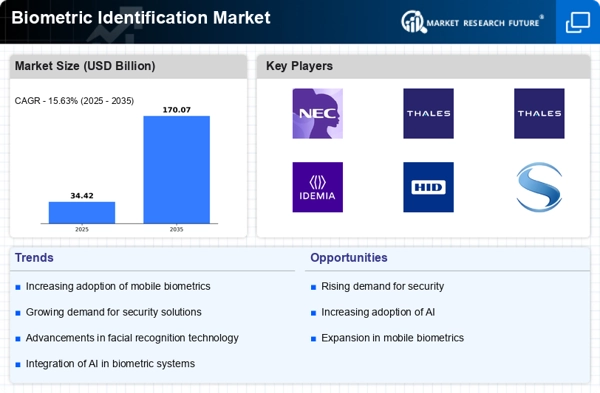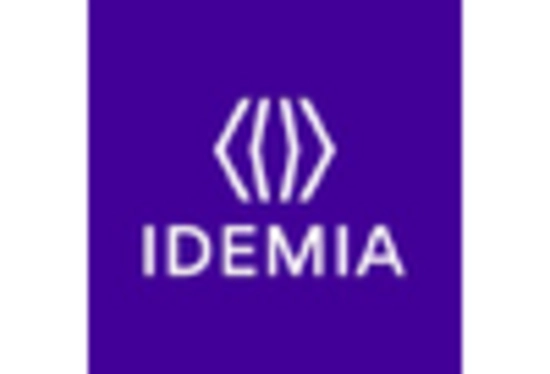Rising Security Concerns
The increasing prevalence of security breaches and identity theft incidents has heightened the demand for robust security solutions. Organizations across various sectors are increasingly adopting biometric identification technologies to enhance security measures. The Biometric Identification Market is witnessing a surge in demand as businesses seek to protect sensitive data and ensure secure access to facilities. According to recent data, the market is projected to grow at a compound annual growth rate of over 20% in the coming years. This growth is driven by the need for advanced security systems that can effectively mitigate risks associated with unauthorized access and fraud. As a result, the integration of biometric solutions is becoming a standard practice in sectors such as finance, healthcare, and government, where security is paramount.
Technological Advancements
Rapid advancements in biometric technologies, including fingerprint recognition, facial recognition, and iris scanning, are propelling the Biometric Identification Market forward. Innovations in sensor technology and artificial intelligence are enhancing the accuracy and efficiency of biometric systems. For instance, the introduction of deep learning algorithms has significantly improved the performance of facial recognition systems, making them more reliable and faster. The market is expected to witness a substantial increase in the adoption of these advanced technologies, with projections indicating a potential market size exceeding USD 50 billion by 2027. This growth is indicative of the industry's response to the evolving needs of consumers and organizations seeking more sophisticated identification solutions.
Increased Consumer Awareness
As consumers become more aware of the benefits of biometric identification, the demand for these technologies is on the rise. The Biometric Identification Market is witnessing a shift in consumer preferences, with individuals seeking more secure and convenient methods of authentication. This awareness is driven by the proliferation of biometric-enabled devices, such as smartphones and wearables, which have made biometric technology more accessible to the general public. Surveys indicate that a significant percentage of consumers are willing to adopt biometric solutions for personal security and convenience. This growing acceptance is likely to encourage businesses to invest in biometric systems, further propelling market growth. The trend suggests a future where biometric identification becomes a standard feature in everyday transactions and interactions.
Government Initiatives and Regulations
Government initiatives aimed at enhancing national security and public safety are driving the growth of the Biometric Identification Market. Various countries are implementing regulations that mandate the use of biometric identification for various applications, including border control, law enforcement, and access to government services. These regulations are fostering an environment conducive to the adoption of biometric technologies. For example, initiatives such as national ID programs and e-passports are becoming increasingly common, leading to a rise in the deployment of biometric systems. The market is likely to benefit from these regulatory frameworks, as they create a structured approach to biometric implementation, ensuring compliance and standardization across different sectors.
Growing Adoption in Financial Services
The financial services sector is increasingly embracing biometric identification technologies to enhance security and streamline customer experiences. Banks and financial institutions are implementing biometric solutions for customer authentication, fraud prevention, and secure transactions. The Biometric Identification Market is experiencing significant growth in this sector, with a notable increase in the use of biometric ATMs and mobile banking applications. Recent studies indicate that the adoption of biometric authentication in financial services could reduce fraud rates by up to 30%. This trend reflects a broader shift towards digital banking, where security and user convenience are paramount. As financial institutions continue to innovate, the demand for biometric solutions is expected to rise, further solidifying the industry's position in the market.

















Leave a Comment